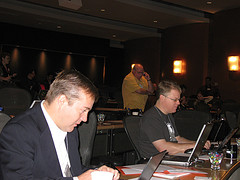 A session on Corporate Blogging Policy with Ben Edwards, Nicki Dugan and Betsy Aoki.
A session on Corporate Blogging Policy with Ben Edwards, Nicki Dugan and Betsy Aoki.
Given that the Thornley Fallis blogging policy is a stripped down, “Blog smart and Don’t cause harm to any person,” I figured I could pick up some useful advice about what I have been missing.
Nicki Dugan is responsible for Yahoo’s corporate blog. Similar to other companies, employees were blogging on their own for quite some time. They developed a set of guidelines to provide some indicators of acceptable behaviour for employees. Some of the main signposts:
- If you mess up, it’s your neck
- Remember your confidentiality agreement
- Be respectful of your colleagues
- Get your facts straight
- Provide context to your arguement
- Engage in private feedback
- Remember that whatever you write will follow you everywhere
The publication of the guidelines provided a sense of security to the employee bloggers. They understood the parameters of acceptable blogging and they could blog without fear.
 Ben Edwards of IBM runs the IBM blogging program through the department of new media communications.
Ben Edwards of IBM runs the IBM blogging program through the department of new media communications.
The IBM guidelines encourage employees to blog. It’s in your interest to get involved and to understand what is going on in this area. And it’s in the corporation’s interest.
The guidelines were developed using a wiki with input from the company’s established bloggers. The guidelines are posted on IBM’s site.
IBM also publishes a list of its outward facing bloggers on its Web site. The bloggers listed here are writing about things related to the company’s business. Personal or hobby sites are not listed in the directory.
Ben believes that blogging is very much a minority activity within the company. A lot of people find it to be too time consuming. He views it as a very useful information sharing tool. And it provides an archive of information.
 Betsy Aoki joined Microsoft in 2003. At that time, there were a number of employees already blogging. At the professiona developers conference of 2003, there were a large number of employees who wanted to blog and continued to blog after that.
Betsy Aoki joined Microsoft in 2003. At that time, there were a number of employees already blogging. At the professiona developers conference of 2003, there were a large number of employees who wanted to blog and continued to blog after that.
Microsoft still does not have a formal blogging policy beyond “blog smart.” This was a huge leap forward in executive thinking. The company could not tell you ahead of time what the right answer was ahead of time. The company was empowering employees to think for themselves and determine what the right thing to do and say would be. This allowed the company to evolve and to be flexible. Robert Scoble was able to use this approach as a means to speak freely in his blog. This approach has had positive impact both on the company’s image and on employee morale.
Ben Edwards pointed out that “a set of guidelines won’t get you very far. It’s much more a cultural question. You are empowering employees. … The key is cultural. And that means involvement from the top.”
Betsy Aoki added that “the main reason you should be blogging is for your customers. If you want a completely scalable way to talk with your customers. …. If you can engage with your customers. Interact more with your customers. Increase the loyalty of your customers, then you should do it. … So, the real question is, do your customers want you to blog. If the answer is yes, then you should do it.”
Question: Have the internal blogs changed the relationship between senior management and the employees? Ben Edward spoke of the large number of IBM pensioners who were upset about the handling of a pension issue. A senior IBM executive wrote a post about this which received a number of angry comments. This was healthy as it showed a willingness to open discussion.
 So, I’d like your help. If you’re still subscribed to my feed after the past week of silence, I’d really appreciate your suggestions about what is interesting in the PR blogosphere right now. Please point me to the best posts from other PR/marketing blogs during the last week.
So, I’d like your help. If you’re still subscribed to my feed after the past week of silence, I’d really appreciate your suggestions about what is interesting in the PR blogosphere right now. Please point me to the best posts from other PR/marketing blogs during the last week.


 Michael O’Connor Clarke
Michael O’Connor Clarke







 Tris Hussey
Tris Hussey
 Robert Scoble
Robert Scoble